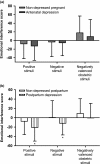Different patterns of attentional bias in antenatal and postpartum depression
- PMID: 29201545
- PMCID: PMC5698862
- DOI: 10.1002/brb3.844
Different patterns of attentional bias in antenatal and postpartum depression
Abstract
Background: Biased information processing in attention, memory, and interpretation is proposed to be central cognitive alterations in patients with major depressive disorder, but studies in women with peripartum depression are scarce. Because of the many similarities with depression in nonperipartum states as regards symptom profile and risk factors, we hypothesized that women with antenatal and postpartum depression would display attentional bias to negatively and positively valenced words.
Methods: One hundred and seventy-seven pregnant and 157 postpartum women were included. Among these, 40 suffered from antenatal depressive disorder and 33 from postpartum depressive disorder. An emotional Stroop task with neutral, positive, negative, and negatively valenced obstetric words was used.
Results: No significant difference in emotional interference scores was noted between women with antenatal depression and nondepressed pregnant women. In contrast, women with postpartum depression displayed shorter reaction times to both positive (p = .028) and negative (p = .022) stimuli, compared with neutral words. Pregnant women on antidepressant treatment displayed longer reaction times to negatively valenced obstetric words in comparison with untreated depressed women (p = .012), and a trend toward greater interference in comparison with controls (p = .061).
Conclusions: In contrast with the hypothesis, we found no evidence of attentional bias to emotionally valenced stimuli in women with untreated peripartum depression. However, the shorter reaction times to emotional stimuli in women with postpartum depression may indicate emotional numbing, which in turn, is a functional impairment that may have repercussions for child development and well-being. Our findings emphasize the need to identify and treat women with postpartum depression at the earliest possible time point to ensure swift recovery and support for the family.
Keywords: antenatal depression; attentional bias; emotional Stroop; postpartum depression; pregnancy; women.
Figures


Similar articles
-
Depression During Pregnancy and Postpartum.Curr Psychiatry Rep. 2016 Mar;18(3):32. doi: 10.1007/s11920-016-0664-7. Curr Psychiatry Rep. 2016. PMID: 26879925 Review.
-
Phenotypic differences between pregnancy-onset and postpartum-onset major depressive disorder.J Clin Psychiatry. 2012 Dec;73(12):e1485-91. doi: 10.4088/JCP.12m07693. J Clin Psychiatry. 2012. PMID: 23290332
-
Are symptom features of depression during pregnancy, the postpartum period and outside the peripartum period distinct? Results from a nationally representative sample using item response theory (IRT).Depress Anxiety. 2015 Feb;32(2):129-40. doi: 10.1002/da.22334. Epub 2014 Nov 25. Depress Anxiety. 2015. PMID: 25424539 Free PMC article.
-
Emotional memory in pregnant women at risk for postpartum depression.Psychiatry Res. 2015 Oct 30;229(3):777-83. doi: 10.1016/j.psychres.2015.08.003. Epub 2015 Aug 3. Psychiatry Res. 2015. PMID: 26272023
-
Peripartum depression: Early recognition improves outcomes.Cleve Clin J Med. 2017 May;84(5):388-396. doi: 10.3949/ccjm.84a.14060. Cleve Clin J Med. 2017. PMID: 28530897 Review.
Cited by
-
Attentional bias to threat is modulated by stimulus content: an fNIRS study.Front Hum Neurosci. 2024 Jan 11;17:1308457. doi: 10.3389/fnhum.2023.1308457. eCollection 2023. Front Hum Neurosci. 2024. PMID: 38273882 Free PMC article.
-
Perinatal depression and its impact on infant outcomes and maternal-nurse SMS communication in a cohort of Kenyan women.BMC Pregnancy Childbirth. 2022 Sep 22;22(1):723. doi: 10.1186/s12884-022-05039-6. BMC Pregnancy Childbirth. 2022. PMID: 36138357 Free PMC article.
-
Physical Activity and the Occurrence of Postnatal Depression-A Systematic Review.Medicina (Kaunas). 2019 Sep 2;55(9):560. doi: 10.3390/medicina55090560. Medicina (Kaunas). 2019. PMID: 31480778 Free PMC article.
-
Cohort profile: the Biology, Affect, Stress, Imaging and Cognition (BASIC) study on perinatal depression in a population-based Swedish cohort.BMJ Open. 2019 Oct 22;9(10):e031514. doi: 10.1136/bmjopen-2019-031514. BMJ Open. 2019. PMID: 31641004 Free PMC article.
-
Depressive Symptoms in Late Pregnancy Disrupt Attentional Processing of Negative-Positive Emotion: An Eye-Movement Study.Front Psychiatry. 2019 Oct 31;10:780. doi: 10.3389/fpsyt.2019.00780. eCollection 2019. Front Psychiatry. 2019. PMID: 31736800 Free PMC article.
References
-
- American Psychiatric Association (2013). Diagnostic and statistical manual of mental disorders, fifth edition (DSM‐5). Arlington, VA: American Psychiatric Publishing.
-
- Banich, M. T. (2009). Executive function: The search for an integrated account. Current Directions in Psychological Science, 18, 89–94.
-
- Bar‐Haim, Y. , Lamy, D. , Pergamin, L. , Bakermans‐Kranenburg, M. J. , & van IJzendoorn, M. H. (2007). Threat‐related attentional bias in anxious and nonanxious individuals: A meta‐analytic study. Psychological Bulletin, 133(1), 1–24. - PubMed
MeSH terms
Substances
LinkOut - more resources
Full Text Sources
Other Literature Sources
Medical

